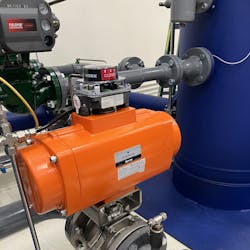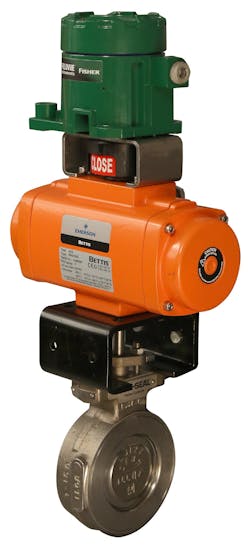Position transmitters improve critical isolation valve reliability

Automated isolation on/off valves are found throughout most process plants, where they are used to arrest reactant flows, isolate and protect equipment, divert process media and perform other functions. Many of these tasks are paramount for process operations, and some are part of the safety shutdown systems that protect plant personnel and equipment.
Isolation valves are typically outfitted with open and closed limit switches to provide valve position feedback. Unfortunately, the on/off nature of the switches severely limits the ability to diagnose valve performance, so a degrading valve can go unnoticed until it fails. Such a failure can have serious process implications, and it can pose safety risks as well.
HART-enabled position transmitters offer a cost-effective solution to this problem. These transmitters are easy to calibrate, and some incorporate a proven, linkage-less design. They also provide much higher reliability, SIL 2 capabilities and valve diagnostics — often required for critical isolation valve applications.
Limit switch constraints
Though simple in design and function, automated isolation on/off valves provide an important service in process plants. While control valves adjust the process flow itself, isolation valves actuate to stop reactant flow, protect equipment and direct process flows around molecular sieves, pressure swing absorbers, reactor jackets and other process equipment.
Historically these valves have been outfitted with open and close limit switches to indicate valve position (Figure 1). This is an inexpensive option that works well in many cases, but it does have limitations that can pose problems for critical valve applications.
On/off switches indicate gross position, but their lack of a continuous analog signal proportional to position limits the ability to employ any meaningful diagnostics, so a failure may go unnoticed for some time. Quite simply, one cannot know if the switch does not work until it is called into action and fails to function. Depending on how the limit switches are set, the valve may be sticking or partially stroking, in either case failing to reach full travel, yet the position switches will still indicate the valve is working as desired.
Another challenge for limit switches involves their installation. Isolation valves are typically reciprocating (valve shaft moves up/down) or rotary (valve shaft spins). To actuate the limit switch, some kind of mechanical linkage must be employed to sense the shaft movement and translate it into a motion that actuates the switch. Depending on the physical configuration of the valve, these linkages can be complicated, and difficult to set up and maintain. They are also prone to error and outright failure as the linkages wear and slip. Premature failure is particularly common in applications with high cycling or excessive vibration.
A better alternative
A position transmitter (Figure 2) offers an inherent advantage over limit switches since it provides a continuous position indication throughout the valve stroke. If a valve is failing to reach the end-of-stroke or hanging/sticking during transition, this is immediately apparent from the position signal. Also, a failure of the transmitter itself is instantly detected, and it can be flagged for repair as soon as the continuous signal is lost.
All these features result in much higher reliability for the device, allowing it to carry an SIL 2 rating. The position transmitter also includes limit switch outputs, so it can be retrofitted into an existing on/off switch circuit, while taking advantage of the valve position information.
This new design also addresses the mechanical linkage problems that bedevil limit switches. Instead of mechanical linkages, this design utilizes fully linkage-less, non-contacting magnetic assemblies with hall effect sensors that have proven to be very reliable in over 20 years of service on 2,000,000 positioner applications (Figure 3). One beneficial feature incorporated into some limit switches is a visual indicator, allowing technicians to see valve position in the field. For example, the Fisher FIELDVUE 4400 has this for rotary applications as well, while still maintaining a fully linkage-less design.
Calibration is quick and easy as it only requires the user to simply move the valve to the end-of- stroke positions, and then press the zero and span buttons. The device also incorporates HART communications, allowing access to a host of more advanced diagnostic data, and enabling remote access and set up.
Applications
Modern position transmitters are well suited for a number of critical valve applications where limit switches have historically been used. Common applications include:
- Chemical reactor feed shutdown valves: The added reliability and available diagnostics on a valve position transmitter allow the shutdown valve assembly to carry a higher SIL rating and/or extend test intervals. The position information also provides real-time measurement of valve stroke, and it indicates when a valve is starting to plug or stick.
- Pressure swing adsorption valves: Pressure swing adsorption units rely on fast-acting, tightly closing valves to achieve and maintain performance. A slow-moving or leaking valve can have a serious negative impact on efficiency and impact production. Valve positioners have been utilized for valve diagnostics and position monitoring, but a valve position transmitter achieves the same function at a substantially reduced cost. The linkage-less design provides greatly improved reliability as compared to limit switches in this high cycling application.
- Mineral pressure oxidation isolation valves: The mining industry often uses high-pressure, high-temperature vessels to extract precious metals and minerals from the ore. The process is punishing for equipment, erodes and corrodes control valves, and poses high pressure and temperature exposure issues during unit operation. Fast-acting isolation valves are necessary to contain the process during shutdowns or allow equipment switching during operation. Improved diagnostics on isolation valves provide early indications of problems, or alerts operators to valves that are starting to stick or hang.
- Steam generator shutdown valves: Boilers often employ a number of isolation valves that are critical to operations. Shutdown valves on fuel trains, vent and drain valves around the steam drum, and air damper valves all benefit from the advanced diagnostics and the improved SIL ratings and reliability provided by a valve position transmitter. These transmitters can be easily incorporated into the existing safety system in installations where the position transmitter includes limit switch outputs.
Conclusion
Position transmitters that incorporate linkage-less sensors and integral limit switch outputs offer a cost-effective means to upgrade the reliability and SIL rating of existing isolation valve assemblies. The elimination of mechanical linkages makes the valve far less susceptible to vibration damage, and it greatly simplifies installation and calibration.
The HART-enabled signal provides a high level of diagnostics and allows the plant to monitor cycle count, stroke time, valve travel and other parameters that are not available from a standard limit switch package. Most importantly, the transmitter allows operations and maintenance personnel to detect developing valve problems, and to then proactively plan and act on these issues before outright failure occurs.
If isolation valve reliability is causing problems in your plant, consult your automation vendor about the possibility of replacing the limit switch assemblies with valve position transmitters. The transmitters work on either rotary or linear actuators, and the inclusion of both a continuous analog signal, as well as two digital switch signals, allows the device to be easily retrofitted into most applications where a set of limit switches is installed.
Kurtis Jensen is a portfolio manager for Emerson responsible for product development, serving as an advocate and promoter of innovative technologies that benefit end users. He has over 40 years’ experience in field service, system integration, asset management, cybersecurity wireless technologies and field instrumentation.
Tyler Reeder is a sales engineer at Emerson, working in Global Industry Sales. His focus is on the oil and gas industry, handling both the upstream and midstream markets. Reeder is a graduate of Iowa State University with a Bachelor of Science in Mechanical Engineering.
About the Author
Kurtis Jensen
Portfolio manager for Emerson
Kurtis Jensen is a portfolio manager for Emerson responsible for product development, serving as an advocate and promoter of innovative technologies that benefit end users. He has over 40 years’ experience in field service, system integration, asset management, cybersecurity wireless technologies and field instrumentation.
Tyler Reeder
Sales engineer at Emerson
Tyler Reeder is a sales engineer at Emerson, working in Global Industry Sales. His focus is on the oil and gas industry, handling both the upstream and midstream markets. Reeder is a graduate of Iowa State University with a Bachelor of Science in Mechanical Engineering.

